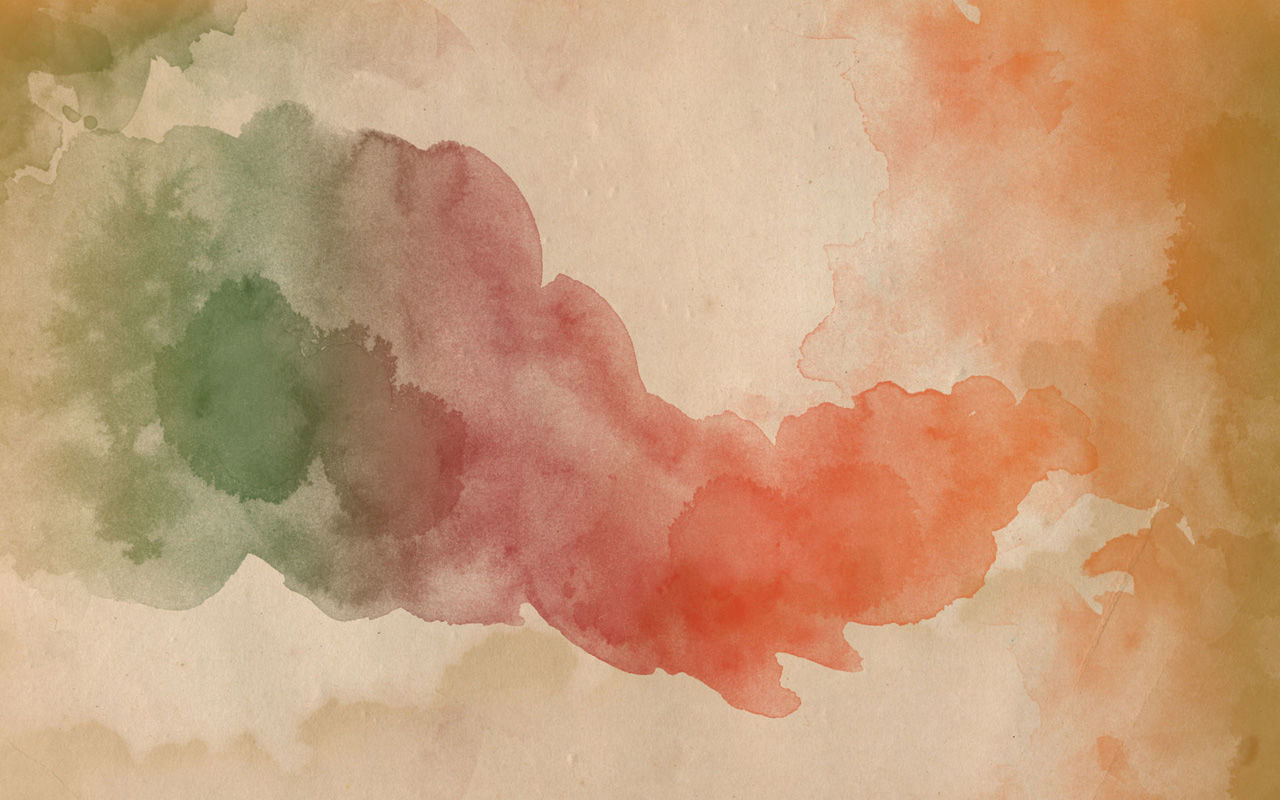
Clouds Over Sidra and The Displaced are two virtual reality films that show the power of virtual reality as a tool of creating empathy, as well as encouraging user immersion and interactivity.
Clouds Over Sidra was a joint effort between the United Nations Sustainable Development Goals, which is part of the United Nations Millennium Campaign, UNICEF, and Vrse. It was directed by Gabo Arora, from the United Nations, and Chris Milk, the founder of Vrse. Clouds Over Sidra is entirely narrated by Sidra, a 12 year old girl who lives in the Za'atari refugee camp.
The Displaced is a virtual reality film that focuses on three children who all experienced some form of displacement. This experience was produced by the New York Times and Within (formally Vrse), and was co-directed by Imraan Ismail of Within and Ben C. Solomon of the New York Times, and creatively directed by Chris Milk and Jake Silverstein of the New York Times. In addition to the film, the New York Times also produced articles focusing on the three children who are focus of the film: Oleg, Chuol, and Hana.
The representation of refugees in Clouds Over Sidra does not essentialize identities. Although Sidra's voice is the only narration as the user is taken on a tour through the refugee camp, she does not claim to speak for the group of people living there. This is made apparent through Sidra giving definite and personal opinions. She does not use the pronoun "we" when talking about her experience in the refugee camp and instead uses the pronoun "I".
At the end of the virtual reality experience, text appears on the screen that states: "The world is facing the most devastating refugee crisis since WWII. As of September 2015, the Za'atari camp in Jordan harbors 80,000 Syrians facing war and famine. No one knowns when it will be safe to go home, nor what will be left for them when they return. To help please visit vrse.com/sidra"
This call to action relies on response one feels after viewing Clouds Over Sidra; if the experience provoked enough empathy, curiosity, or interest, the viewer might feel motivated to visit the web page suggested. This virtual reality experience might also motivate viewers to take action in other ways; next to the video, there is the option to share it on social media to raise awareness for the situation of refugees in the Za'atari camp.
Clouds Over Sidra is unique in its high degrees of immersion and user interactivity, as well as its representation of refugees. Unlike most representations of refugees and vulnerable populations, this experience did not center on suffering. Although Sidra expressed a longing for home and appeared unhappy in certain frames, there was not a unnecessary focus on her pain.
Sidra is represented as a individual, with complex feelings and emotions. She is not cast as a victim in this experience; at one point, she states "Unlike back home, here in Za'atari girls can play football too. That makes us happy." It is rare to hear mention of the good parts of life in a refugee camp, where typically the inhabitants are portrayed as victims in need of a better life.
The experience begins with Sidra's voice and a view of sand, with footprints leading away from the user is positioned; she states: "We walked for days crossing the desert to Jordan. The day before we left my kite got caught in a tree in our front yard. I wonder if it's still there. I want it back."
This statement reflects the values of a typical twelve year old child, concerned with their favorite toy; Sidra does not seem to be stating ideas or words that are not her own. This self-representation allows Sidra an increased sense of agency over her life. As a young girl living in a refugee camp. the visual image of girls who look like Sidra are commonly represented in the media; yet these images usually lack information about the names of the girls pictured, let alone their unique feelings, perspectives, and emotions on the world around them.
Although visual images have the power to evoke emotion in the viewer, the sheer volume of images depicting suffering, refugees, and vulnerable populations has the tendency to encourage antipathy due to moral fatigue. Clouds Over Sidra prevents moral fatigue through its immersive engagement with the user; both the ability to see 360 degrees around the camp, as well as the experience of having an atypical narrator in Sidra, contribute to this immersion.
Above: Za'atari refugee camp in Jordan, photo taken by AP
Below: Sidra from Clouds Over Sidra, screenshot taken by ABC News
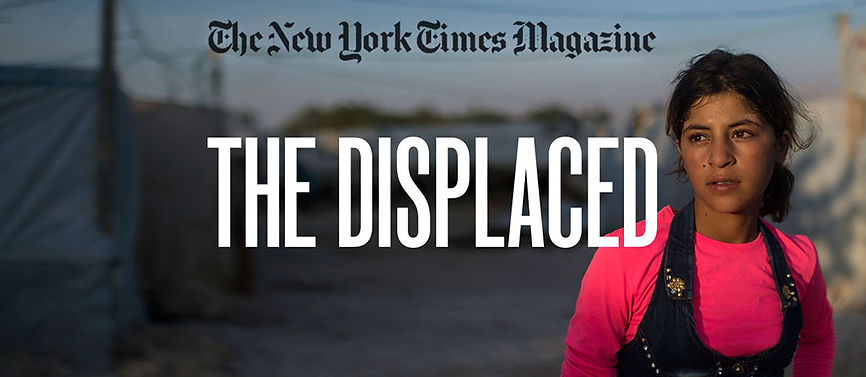

Syrian refugees inside the Za'atari camp, photo by Carolyn Cole
Clouds Over Sidra is entirely narrated by Sidra, a twelve year girl who lives in the Za'atari refugee camp with her family.
The film is primarily meant to be viewed through a virtual reality headset, but can also be viewed on a screen through a internet browser. Although viewing on a flat surface, such as through an internet browser, does not allow one to feel as immersed, there is still a higher level of interactivity than with standard, non-virtual reality films. When viewing wearing a virtual reality headset, the user is able to turn their head (or, if using a internet browser, use their mouse to rotate the screen view) to look around the refugee camp while Sidra is talking. Although one cannot move from where Sidra is standing in the camp, one is able to move along with Sidra when she walks, as well as always being able to look 360 degrees around the camp.
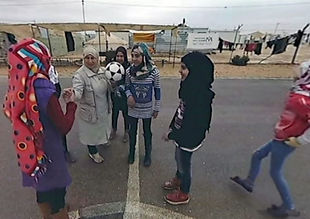

Above: Sidra and her young brother in the Za'atari refugee camp in Jordan
Image taken by Toby Fricker/ UNICEF Jordan

There is a lack of political or historical context in this virtual experience, but the narration is entirely from a young girl who may not have the knowledge (or interest) to mention those topics. Despite Sidra being the narrator, and all of her words seem authentically her own, there is still the role that Vrse and the New York Times played in crafting the final product. It is unknown how much input Sidra had on the final cut of this experience but it can be assumed that other figures had a much larger, if not entire, say. This prevents the idea of this being complete self-representation; there is also the inclusion of numerous 'poignant' quotations that seem to specfically have been chosen to provoke greater empathy.
At the same time, there is also the inclusion of many of Sidra's thoughts that are not exceedingly poignant and instead are humorous or critical, like her statement "Many of the men say they exercise because they want to be strong for the journey home. But I think they just like how they look in the mirror." These opinions, seemingly irrelevant or unimportant compared to the larger story, are still significant as they reveal that Sidra most likely had a certain amount of agency in this self-representation.
The Displaced is a 360 degrees film that explores displacement through the individual narrations of three children, Oleg, Chuol, and Hana. The New York Times, a co-producer and co-director on the project, also wrote accompanying articles that expand on the narratives of the three children.
The film opens with a young boy standing alone in a destroyed room and then cuts to a different child pushing a canoe in a river that is surrounded by tall grasses; as a virtual reality experience, it appears that the viewer is standing close to the canoe before stepping in and setting off down the river with the boy.
Text then appears on the screen that reads: "60 million people around the world have been driven from their homes by war and persecution - more than any time since WWII. Half are children. This is the story of three of them." The film makes this direct connection to World War II, thus providing a historical example for past examples of displacement.
The film also provides a justification for having three children narrate their stories through stating that half of all displaced people are children. Since children are commonly used by humanitarian organizations in advertisements to appeal to viewers' sympathy, having children narrate this film is not unexpected and is most likely also an attempt to broaden the film's appeal to a wider audience. The image below is displayed by UNICEF, a humanitarian aid organization, on their website to describe their purpose and accomplishments.
The three children who narrate the film each have unique identities and opinions about their personal situations. They are from different cultures and their experiences in film reflect that through their choices of discussion topic, personal priorities, and surroundings. Having three children's perspectives on their personal experiences of displacement provides a broader understanding of the variety of situations that displacement encompasses. Although a refugee is the most obvious and widely acknowledged type of displaced person, it is important to recognize the experiences of other forms in order to avoid generalization or silencing of the displaced.

Refugees in La Gleize, Belgium on January 2, 1945. Image by Peter J. Carroll/AP

Two young girls inside a playhouse. Image by UNICEF/Mawa
Oleg, 11 years old, Ukraine
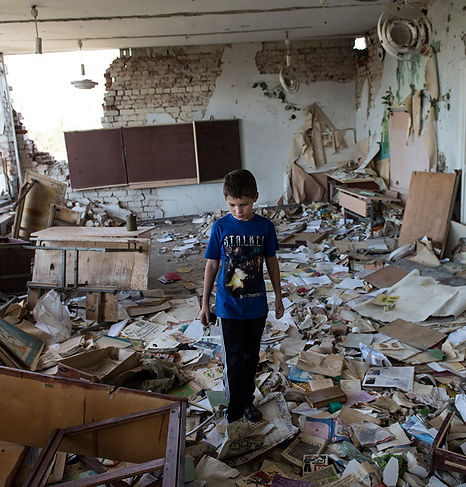
Oleg's section in The Displaced begins with him standing in front of a destroyed building. Text appears on the screen that states "Oleg, 11. Last year, the war in Ukraine forced Oleg and his parents to flee their village. When the fighting subsided, they returned."
Oleg, pictured right, is then shown running around with another young boy, presumably his friend, on the roof of a seemingly abandoned building.
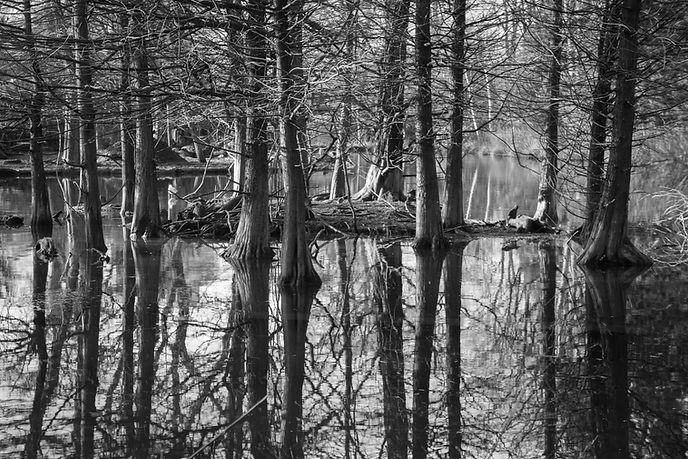
"Before when the teachers would yell at us we'd say, 'Wouldn't it be cool if the school blew up?'
I 'd never say that now. It's very hard but I still have my friends."
- Oleg
This difference that Oleg mentions is shown visually as he continues his narration. Although the viewer is never shown what Oleg's village or his school looked like before the war, the destruction is obvious. The viewer 'follows' Oleg as he visits his old school, which has papers and books strewn around the floor. Oleg appears sad, although he never explicitly states sadness - only fear and hardship.
He rides his bike with his friend around his village and mentions that, despite how difficult it is to see his village destroyed, he still has his friends. This statement reveals his own cultural values of what is important to him - the people in his life. At the end of his narration, Oleg looks directly into the camera and thus into the eyes of the viewer watching him back. This direct gaze is challenging the viewer to acknowledge Oleg's presence, identity, and story; he states "My name is Oleg Teryokbin. I'm 11 years old."
This ending statement is significant in a world where many members in vulnerable populations, such as refugees or displaced peoples, are essentialized into large categories or groupings. These populations are generalized, which often includes a loss of personal identity in the place of stereotypes and misrepresentations. By Oleg firmly stating his own name and his age, he is reaffirming his own identity despite being part of the 'displaced' category.
Chuol, 9 years old, south sudan

Chuol provides the second narration in The Displaced; he first appears standing in the water (pictured left), frowning at the camera and thus at the viewer, if the viewer chooses to look directly in front of them. Since this film is a 360 degrees experience, the viewer has the option to look away from Chuol's gaze or look back. Although this could be interpreted as problematic, as it allows the viewer to 'opt out' instead of being forced to engage with Chuol, who is obviously upset.
However, the point of 360 degrees videos and other virtual reality films is to provide immersion and interactivity. The viewer who chooses to gaze back at Chuol is making the choice to engage in his story and experience; this creates a more powerful connection than a viewer who is forced, without caring or desiring, to meet his gaze.
Without Chuol speaking, text appears on the screen that states "Over the summer Chuol's village in South Sudan was attacked. He fled with his grandmother to an island in the swamp."
Chuol begins to speak, continuing where the narration left over: "When they attacked we fled to the swamp but it is better than being killed by the fighters. In the morning my mother was gone. We were separated by the confusion."
Chuol's experience is very different than Oleg, the first narrator, or Hana, the third narrator. Unlike Oleg, Chuol lost close family members in a direct attack. He is visibly more angry than Oleg appeared to be; in contrast to Oleg's experience, Chuol is never shown returning to his attacked village or walking among destroyed parts of his former life. Instead, Chuol's experience focus on his solitary activity of rowing a canoe through the swamp, waiting in line for food rations, and sitting among other children in a classroom. Chuol mentions his grandmother briefly in the beginning, but is not shown having close contact with other people during his narration and usually appears alone. His suffering centers on the people in his life he lost, whereas Oleg's suffering focused more on the destruction of his physical village. However, these experiences do not invalidate each other; instead, they explore how displacement, as well as suffering, can take many forms and shapes.
Chuol, pictured right sitting in a classroom, ends his narration in a similar style to Oleg. Chuol gazed into the camera and stated "My name is Chuol. I live in Sudan."
Like Oleg, Chuol stating his name and country establishes his identity. It also reveals that, compared to Oleg, his country is important enough to include in his closing line, as opposed to his age.
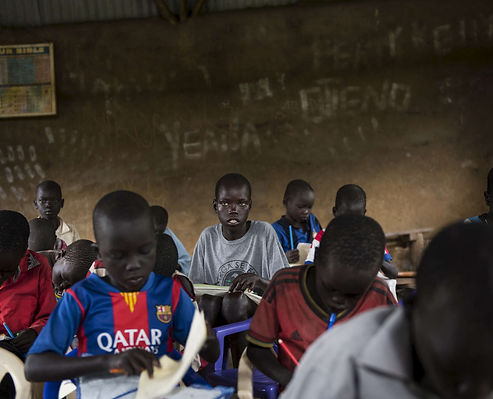
Chuol is an internally displaced individual; comparatively, Oleg was formally displaced but was able to return to his home. Chuol's home, as well as his parents and grandfather, are no longer in his life. Stating his country, Sudan, in his closing statement might have been a reaffirm of his citizenship and belonging to his country, if not his village, as his home.
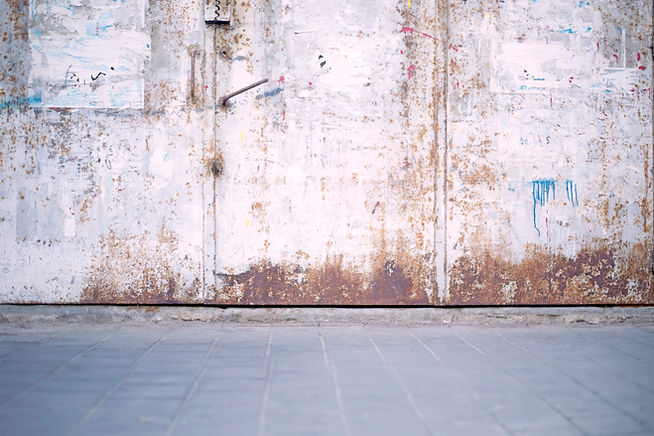
"My father and grandfather never made it. They were put in the house and burned alive."
-Chuol
Hana, 12 Years Old, Syria/Bekaa Valley, Lebanon
Hana's narration is the last presented, after Oleg and Chuol; she first appears standing in a field of grass with text appearing in front of her that says: "Hana, 12. In 2012 Hana and her family left Syria. They now live in a refugee settlement in the Bekaa Valley, Lebanon."
Hana then begins to talk, explaining how she has to wake up at 4 am each morning to work. She discusses how she used to live in Syria but then the war started and she and her family had to go to Lebanon, where they are now waiting. By stating the direct connection between the war in Syria and her current situation as a refugee, Hana is providing political context for the viewer. She is also establishing the point in her life before she was a refugee and instead, she was a citizen of Syria; as this was one of the first sentences of Hana, it is clearly important to her identity to offer this explantation.

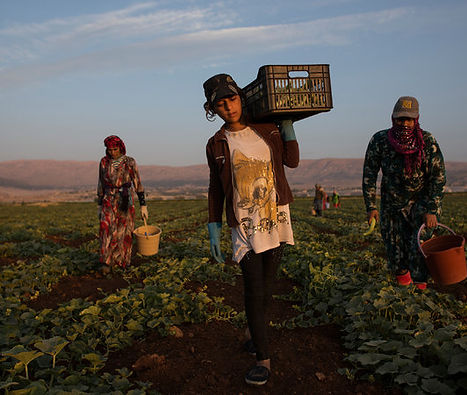
Hana and her family, pictured right, work in nearby farm fields, close to the refugee settlement. Hana helps pick produce in the early morning, which can be difficult and strenuous work. Instead of playing with toys or exploring outside, Hana and her cousins work in the fields due to the war which forced them to leave their homes in Syria. Once the work day is complete, Hana remarks "In Syria, we used to have lots of toys and things to do. Now we only have each other."
His narration is heard while the viewer is able to look around the top of this building and watch Oleg and his friend; he explains how 'the war' came to his village last year and he was very afraid. Oleg then says, "when we got back everything was different."

"I hope one day the war will end. I would like to go back to being a little girl like I was."
-Hana

Clouds Over Sidra
&
The Displaced


Clouds Over Sidra

"I think being here for a year and a half has been long enough. I will not be twelve forever. And I will not be in Za'atari forever.
My teacher said the clouds moving over us also came from Syria.
Someday the clouds and me are going to turn around and go back home" - Sidra

The Displaced
In the same manner this format allowed Oleg and Chuol an increased sense of agency, Hana is also able to better self-represent herself and her viewpoints through a 360 degrees video compared to a traditional medium, like a news story of photograph. Although photographs are important in that they allow the viewer to better visualize the environment of the subject, photographs often are deceptive. It is difficult to fully understand the background, complex identity, or opinions of the person in the photograph; at times, even the subject's name is unknown in a photograph.
Through this 360 degrees video, Hana and the other children were able to ensure that their names, as well as their identities and options, were known. This is important in terms of the politics of representation; although Hana identities herself as living in a refugee settlement, she does not claim to be a voice for all refugees. Instead, she gives her own narrative on her personal and unique situation, which adds to the narrative of refugees as a whole. But instead of contributing to the narrative of refugees as all being the same, such as being victims in need of aid, Hana's story adds to the idea that refugees are individual people with different goals and desires.
Hana ends her narration in the same fashion as Oleg and Chuol; she stares directly into the camera and says, "My name is Hana and I'm 12 years old." Once again, she is reasserting her identity; this is especially significant in regards to how news outlets and media companies represent refugees and displaced people in overly generalized terms. Much coverage on refugees focus on the idea of refugees as a 'mass of victims,' instead of highlighting individual faces and names; this can lead to dehumanization once the individual is forgotten. New forms of technology, such as 360 degrees videos, which allow better self-representation and an immersive experience can reduce this dehumanization of refugees and other vulnerable populations.